by Coffee Kevin | Apr 6, 2016 |
The Bonavita coffee makers are the current coffee maker for everyman. They are easy to use, forgiving of those who do not self-identify as geeks; those of us who just want to scoop our grounds in, fill with water and press go. Bonavita coffee makers were originally Melitta units, the first generation designed in Germany by Melitta, who license their brand name to Hamilton Beach in the US.
Bonavita coffee makers were originally Melitta units, the first generation designed in Germany by Melitta, who license their brand name to Hamilton Beach in the US.
Espresso Supply distributes them and, when Espresso Supply took over their distribution, I had my doubts. Their background is, as the name implies, espresso. They have a separate line of manual brewers, including a widely used variable temperature kettle. They had no experience with electrics. Yet, the public and cafes seem delighted with this company’s approach.
What Espresso Supply is, is dedicated to brewing coffee. This means they really seem to understand both the consumer (you and me) and the process, and it shows in just about everything they do. I met Chris Legler, their Financial Strategist, a few years ago now. Now, if you know me, you’ll know this is a role I would usually dismiss as one of the suits, about as useful to know as Human Resources. As I got to know Chris, I developed a lot of respect for his devotion to coffee and brewing. I came to learn he worked for Sony, a company I long ago admired for their understanding of their audience and both sound and visual products, at least in their heyday.
I see Chris the same way, and I invite you to eavesdrop on a more or less typical conversation between us about brewing. Note: He has no problem discussing any brand of coffee product. He realizes we’re discussing something bigger and has that sense of history not often found in corporate cultures. And, he actually seems to use his (and everyone’s) coffee brewing products!
This podcast was recorded at the NCA Conference in San Diego in March, 2016. Thanks to Joe DeRupo, NCA’s Director of External Relations and Communication, who provided the recording space.
Podcast: Play in new window | Download
Subscribe: Android | Email |
by Coffee Kevin | Mar 16, 2016 |
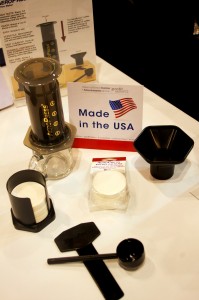 The International Housewares Show is another important trade show for coffee, yet it seems to attract few other coffee journalists. Why? I assume it is because many writers are still stuck thinking coffee is just another beverage ala wine or beer. Those items are brought to their final greatness, then sealed in packages until consumers open and drink them. Period. Coffee is different and a key to its greatness is the final brewing step. At a café, this is someone else’s challenge. At home, where 70% of it is consumed according to the National Coffee Association, the brewing equipment is an obvious dramatic ultimate creator of coffee flavor as it conducts the alchemy which extracts the glorious complex notes from our prized coffee beans. This year’s Housewares show featured a number of important pieces of gear that those of us who know of brewing’s role, will find beneficial to our quest to enjoy the world’s best coffee at home. Here’s my short list:
The International Housewares Show is another important trade show for coffee, yet it seems to attract few other coffee journalists. Why? I assume it is because many writers are still stuck thinking coffee is just another beverage ala wine or beer. Those items are brought to their final greatness, then sealed in packages until consumers open and drink them. Period. Coffee is different and a key to its greatness is the final brewing step. At a café, this is someone else’s challenge. At home, where 70% of it is consumed according to the National Coffee Association, the brewing equipment is an obvious dramatic ultimate creator of coffee flavor as it conducts the alchemy which extracts the glorious complex notes from our prized coffee beans. This year’s Housewares show featured a number of important pieces of gear that those of us who know of brewing’s role, will find beneficial to our quest to enjoy the world’s best coffee at home. Here’s my short list:
Behmor’s Joe Behm has single-handedly driven the coffee brewing world to new heights. Before Joe, the brewing world seemed to sit on its collective hind end and got hung up adding alarm clocks other useless features to its products. Joe created the first multiple temperature brewer, the first once since the lengendary Chemex Automatic that had pre-infusion (for fresh-roasted/fresh-ground coffee). Joe’s Behmor brewer was the first I ever tested that acknowledged the fact that anyone living in high-altitude cities wasn’t able to brew at near ideal water temperatures and added an attitude setting. This past year, Joe became the first one to issue a coffee brewer that can be operated by your smart phone. Before you say, “so what?” and wags issue lame jokes about our modern society not being able to press the “on” button, let me quickly explain what this really means. It means being able to control many variables too numerous to accomplish simply by adding buttons. It means taking advantage of the phone’s better interface to those features, which will soon include not only brewing temperatures and pre-infusion times, but things heretofore only available to manual craft brewers, such as rest periods between pours during brewing. 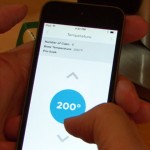 Best of all, and most important in my view, is the connected feature that lets your favorite roasters upload their own personal favorite brewing parameters to the Behmor website. Let’s explore this scenario: Let’s say Jeff Duggan at LA’s Portola roasters decides that his latest Panama Geisha is ideally brewed at a temperature of 197°F. When it’s brewed within its ideal window of fourteen days from roast, it requires a 1 ½ minute pre-infusion of water to settle the grounds before brewing starts; after that it does best with a fifteen second spacing between pours throughout the brew cycle. Then Jeff uploads those parameters to the Behmor web site, aside other similar instructions for various beans. You go there using your phone app, download it and press go. The Brazen Connected brewer just went from being one of the most extensive to use to being one of the simplest. That’s why it’s important.
Best of all, and most important in my view, is the connected feature that lets your favorite roasters upload their own personal favorite brewing parameters to the Behmor website. Let’s explore this scenario: Let’s say Jeff Duggan at LA’s Portola roasters decides that his latest Panama Geisha is ideally brewed at a temperature of 197°F. When it’s brewed within its ideal window of fourteen days from roast, it requires a 1 ½ minute pre-infusion of water to settle the grounds before brewing starts; after that it does best with a fifteen second spacing between pours throughout the brew cycle. Then Jeff uploads those parameters to the Behmor web site, aside other similar instructions for various beans. You go there using your phone app, download it and press go. The Brazen Connected brewer just went from being one of the most extensive to use to being one of the simplest. That’s why it’s important.
Bonavita is distributed by Espresso Supply. This is good because Espresso Supply has very close contact with many roasters, some who’ve become for the first time comfortable carrying and endorsing an electric home automatic drip brewer. The public too, has become very comfortable with SCAA industry-certified automatic home brewers thanks to Espresso Supply. They distribute Bonavita gear and make some of their own. They also introduced two reusable K-cups, a plastic one made in the USA and a stainless version not made in USA. I snared a sample and will test it soon. A new Bonavita 5-cup brewer is undergoing my testing right now.
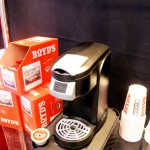 Boyd’s Coffee Company distributes Behmor, and so shared their booth with Joe Behm and with their own TechniBrew International brand. Boyd’s is an unusual coffee company because they are a large wholesaler and coffee brand, especially strong in the Pacific Northwest, but also employ engineers and have a piece in other coffee brewers. One, which I think they own but are branding through the name TechniBrew (they used to be the Technivorm’s US distributor) is a K-cup pod brewer. Before this publication’s fans stop reading, you should know that this one possibly deserves your attention for two reasons. First, although I have not yet officially tested it for review, Boyd’s designed it to fully meet industry brewing standards. I’ve tested one other K-Cup pod brewer that claimed this (made by Bunn) and that unit did prove to me that much of the coffee aficionado’s distaste for this format is due to lackluster brewers that use it, not the format itself. Inventor/Engineer Dave Wheeler of Boyd’s told me the TechniBrew K-cup brewer will meet all SCAA Brewer certification standards. Please note: The SCAA does not review nor certify K-cup brewers. In a casual tasting at their booth, I must say I did find the coffee of a different level than with other K-cup brewers, but of course that is a totally unscientific and anecdotal comment. Boyd’s also designed their K-cup products so they are 100% compostable. From an environmental point of view, this is even more significant.
Boyd’s Coffee Company distributes Behmor, and so shared their booth with Joe Behm and with their own TechniBrew International brand. Boyd’s is an unusual coffee company because they are a large wholesaler and coffee brand, especially strong in the Pacific Northwest, but also employ engineers and have a piece in other coffee brewers. One, which I think they own but are branding through the name TechniBrew (they used to be the Technivorm’s US distributor) is a K-cup pod brewer. Before this publication’s fans stop reading, you should know that this one possibly deserves your attention for two reasons. First, although I have not yet officially tested it for review, Boyd’s designed it to fully meet industry brewing standards. I’ve tested one other K-Cup pod brewer that claimed this (made by Bunn) and that unit did prove to me that much of the coffee aficionado’s distaste for this format is due to lackluster brewers that use it, not the format itself. Inventor/Engineer Dave Wheeler of Boyd’s told me the TechniBrew K-cup brewer will meet all SCAA Brewer certification standards. Please note: The SCAA does not review nor certify K-cup brewers. In a casual tasting at their booth, I must say I did find the coffee of a different level than with other K-cup brewers, but of course that is a totally unscientific and anecdotal comment. Boyd’s also designed their K-cup products so they are 100% compostable. From an environmental point of view, this is even more significant.
It’s a little known fact that Brewista is the brainchild of Brian Gross, likely as close as the coffee world has to a Henry Ford. Brian is a genius and inventor. He is co-owner of BonaVita, whose coffee makers are the current everyman’s favorite, but created Brewista as if he became bored with owning just one great company. Brewista even seems to compete with Bonavita on some levels, something I can’t say I understand. Brewista makes the only coffee brewer other than AeroPress which is made in the USA, Cheyenne, Wyoming to be precise. It’s called the Brewista Steeping Filter, and it is a hybrid steep and drip manual pourover. They’ve also got a number of kettles, scales, and other gear. While Brian seems to be aiming Brewista to mostly be lower-cost Bonavita equivalent gear, he revealed an inventive variable spout kettle that allows the user to control flow and thrust. I know of at least one prominent end user who eschews goose-neck kettles for his Chemex pours because he can’t get enough flow and power in order to “push the grounds around” (their words). Most interesting to me is that Brian is developing different paper filter grades to appeal (I think) to different folks’ tastes on filter. More on that as I learn more from Brian. If you listen to the podcast clip you’ll understand why I can only process a percentage of Brian’s mind while he’s on a roll.
Bunn exhibited a newer, simplified and less expensive single cup Trifecta. They’ve taken their previous two buttons, one controlling time and the other turbidity (using air blown through the brew chamber to stir things up) and made a single button that combines the two. While I despair at losing any functionality of this brilliant and unique machine (both Bunn’s commercial and home marketing teams really blew it in my humble opinion), I think the single button might be justified if it brings the Trifecta into spitting price distance of say a Technivorm, whoops – MoccaMaster. Coleman Garcia brought several new
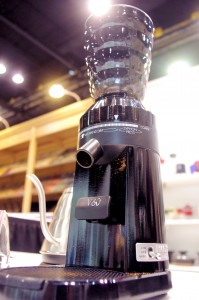 Hario products to IHA. One was actually premiered at CoffeeCon LA in January, well ahead of this trade event. It’s a programmable infrared heater for the Hario Siphon. While their previous product is functional and makes a compelling statement to the already visual home theater experience of making coffee, this new unit offers a touch screen and it’s able to record user information, including the ability to record and repeat your personal siphon brewing method and timings, making it even more beautiful. Suggested retail pricing will be $500. It is awaiting US approvals, but I predict it will be a big seller among this method’s fans. Hario has introduced metal V60s and accompanying matching black, gold and silver aluminum stands. I may be fine with my plastic version, but I also expect these to move into home setups soon. They had their already-well known Mizudashi Immersion cold coffee Brewer there as well. Finally, Hario introduced a home grinder, optimized to accompany and even grind directly into a V60 cone. It also features front panel indicators for Press, V60 and Siphon. While Coleman humbly referred to it as a brand extension, I can imagine a lot of interest as their core audience is sophisticated enough to appreciate a grinder and has a fervent interest in any product labeled Hario, similar to the Apple brand allure.
Hario products to IHA. One was actually premiered at CoffeeCon LA in January, well ahead of this trade event. It’s a programmable infrared heater for the Hario Siphon. While their previous product is functional and makes a compelling statement to the already visual home theater experience of making coffee, this new unit offers a touch screen and it’s able to record user information, including the ability to record and repeat your personal siphon brewing method and timings, making it even more beautiful. Suggested retail pricing will be $500. It is awaiting US approvals, but I predict it will be a big seller among this method’s fans. Hario has introduced metal V60s and accompanying matching black, gold and silver aluminum stands. I may be fine with my plastic version, but I also expect these to move into home setups soon. They had their already-well known Mizudashi Immersion cold coffee Brewer there as well. Finally, Hario introduced a home grinder, optimized to accompany and even grind directly into a V60 cone. It also features front panel indicators for Press, V60 and Siphon. While Coleman humbly referred to it as a brand extension, I can imagine a lot of interest as their core audience is sophisticated enough to appreciate a grinder and has a fervent interest in any product labeled Hario, similar to the Apple brand allure.
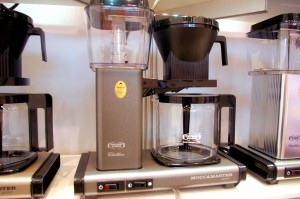 I almost missed them – I keep forgetting that Technivorm is really MoccaMaster. The machines haven’t changed and they likely won’t, and to this brands fans that’s a good thing. MoccaMaster stubbornly refuses to embrace frivolous new features, although some of them in my opinion contribute to taste, but no one can deny they make a great product. They are still hand-built in the Netherlands. They have stuck to all copper heating elements, arguably the best and safest to health. Oh, there is a new color one to add to their array of beautiful ones. A beautiful machine in a geeky way.
I almost missed them – I keep forgetting that Technivorm is really MoccaMaster. The machines haven’t changed and they likely won’t, and to this brands fans that’s a good thing. MoccaMaster stubbornly refuses to embrace frivolous new features, although some of them in my opinion contribute to taste, but no one can deny they make a great product. They are still hand-built in the Netherlands. They have stuck to all copper heating elements, arguably the best and safest to health. Oh, there is a new color one to add to their array of beautiful ones. A beautiful machine in a geeky way.
While all pod machines presume unproven assertions that pre-ground coffee can be kept fresh in those pods, both Nespresso and Illy pod machines have proven to my taste buds that they are capable extractors of taste, given you like the taste they are engineered to deliver. This year, Nespresso has added the connected feature, meaning you can use and app to program, start and keep track of onboard pod inventory with your smart phone.
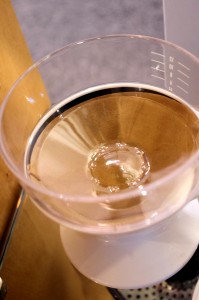 The 12-cup OXO brewer I reviewed recently was getting a lot of attention. Last year OXO brought prototypes and this year they’re all working and their two top brewers earned SCAA certification. To me, the pride of earning this honor with your first machine and one that is able to make 12 cups is noteworthy. OXO’s grinder is also noteworthy because theirs equals a higher priced Baratza grinder (in our grind results tests). One brewer they had that’s spanking new was the OXO Autodrip pourever coffee maker, which makes 6 – 12 ounces of brewed coffee using an innovative cup-marked overhead water reservoir to eliminate guesswork, and which also have a dozen smaller drip holes in order to spread the shower over the grounds. OXO’s Dave Lionetti also told me they’ve played with alternating size and patterned drip holes, which he says enhances the way water falls, agitates and steeps the grounds, which results in a better tasting cup of coffee.
The 12-cup OXO brewer I reviewed recently was getting a lot of attention. Last year OXO brought prototypes and this year they’re all working and their two top brewers earned SCAA certification. To me, the pride of earning this honor with your first machine and one that is able to make 12 cups is noteworthy. OXO’s grinder is also noteworthy because theirs equals a higher priced Baratza grinder (in our grind results tests). One brewer they had that’s spanking new was the OXO Autodrip pourever coffee maker, which makes 6 – 12 ounces of brewed coffee using an innovative cup-marked overhead water reservoir to eliminate guesswork, and which also have a dozen smaller drip holes in order to spread the shower over the grounds. OXO’s Dave Lionetti also told me they’ve played with alternating size and patterned drip holes, which he says enhances the way water falls, agitates and steeps the grounds, which results in a better tasting cup of coffee.
Those are highlights. I reserve the right to add more if I think of them, but those stood out and, once again, Housewares proves to be a great place for coffee brewing products. #Housewares 2016.
by Coffee Kevin | Mar 12, 2015 |
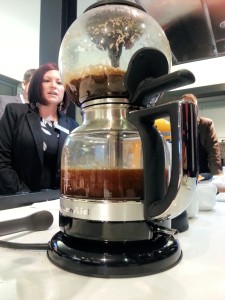 I keep saying that if you don’t get into coffeemakers, your coffee at home will never be great. The best trade show for the gear isn’t a coffee show at all – it’s the International Housewares Show.
I keep saying that if you don’t get into coffeemakers, your coffee at home will never be great. The best trade show for the gear isn’t a coffee show at all – it’s the International Housewares Show.
It’s where I discovered the Chemex, the Aeropress, KitchenAid’s legendary 4-cup, Bonavita, Technivorm and of course my first Bunn, the A10. Not bad for one event! They don’t really want consumers here. I get to go because I keep writing this blog and various articles. Even I used to get ignored because the sellers are always on the lookout for Macy’s buyers. Can’t blame them. I ask a hundred questions and might buy one, where department store buyers are going to buy a case for each store. It keeps me humble.
This year’s event had several new, innovative products. Let me give you a quick (by my standards) rundown. None are reviews. I sometimes look back at first-tastes and see them for the infatuations they are. I believe in long courtships regarding coffeemaker testing. 30 days is the minimum, and it reduces/eliminates new car smell, packaging, and gives me time to do old fashioned things like read the instruction book and tweak products a bit before shooting off my pen, figuratively speaking of course.
 Behmor won the Innovation Award, Kitchen Electrics, International Housewares show award for Joe Behm’s Brazen Connected 8 Cup Brew System. I was perhaps the first to review the Behmor Brazen, so you already know its leading edge position among brewers for its variable temperature setting, variable pre-infusion times (you can actually brew same-day roasted coffee without foaming overflows!) and altitude settings, which likely mean nothing to New Yorkers or Chicagoans, but are the only way to achieve SCAA-recommended brewing temperatures in Denver. Joe won his award (which kept him from showing up at CoffeeCon NYC) for the brand-new “connected” version of his brewer.
Behmor won the Innovation Award, Kitchen Electrics, International Housewares show award for Joe Behm’s Brazen Connected 8 Cup Brew System. I was perhaps the first to review the Behmor Brazen, so you already know its leading edge position among brewers for its variable temperature setting, variable pre-infusion times (you can actually brew same-day roasted coffee without foaming overflows!) and altitude settings, which likely mean nothing to New Yorkers or Chicagoans, but are the only way to achieve SCAA-recommended brewing temperatures in Denver. Joe won his award (which kept him from showing up at CoffeeCon NYC) for the brand-new “connected” version of his brewer.
With the Behmor Connected you will be able to go online and download Counter Culture’s (or other roaster’s) recommended settings for his brewer. This means even more. I can envision barista champs blogging their favorite recipes and settings for coffees ala celebrity chefs (that they really are of course) and finally being able to achieve at home exactly what they are doing in the cafes. Meanwhile, it should double Behmor’s market because more casual consumers who just care about taste, not geeky tweaking, and give them easy downloads to load.
An interesting new startup is Brewista, the brainchild of Bonavita co-owner and inventor, Brian Gross. Brian is one of the great minds of coffee brewing. He talks faster than anyone I’ve ever known, and it’s all content. He’s establishing a coffee product innovation think tank, and future manufacturing site in Cheyenne, Wyoming! He’s releasing a line of simplified Bonavita products that will feature fewer features, and lower costs to bring things like their kettles to a wider audience. Brian is working on online interconnectivity with coffeemakers, which means more sophisticated brewing and simplified operation for sleeping early-morning operators. The thing that he was most excited about was his onsite coffee shop almond milk extractors for cafes. Of course, a home version cannot be far behind. Keep an eye on Brewista. Brian has a great track record with Bonavita, and among coffee’s best overactive imaginations.
 Bunn had a wall of colorful brewers. At first I thought they’d kidnapped an Italian designer and brought them to Springfield, but it turns out they were only for display. They did have their home Trifecta on hand. I can’t help continuing to believe they should sell those in a Bose-style direct program (the pricing/profit margins are too low for mainstream retailers, even so-called high end ones like Sur La Table or Williams-Sonoma). A Connected Trifecta has to be in the works, but if it is, they’re keeping mum about it. Hope they walked the show.
Bunn had a wall of colorful brewers. At first I thought they’d kidnapped an Italian designer and brought them to Springfield, but it turns out they were only for display. They did have their home Trifecta on hand. I can’t help continuing to believe they should sell those in a Bose-style direct program (the pricing/profit margins are too low for mainstream retailers, even so-called high end ones like Sur La Table or Williams-Sonoma). A Connected Trifecta has to be in the works, but if it is, they’re keeping mum about it. Hope they walked the show.
Bunn still makes the best tasting K-cup machine I’ve yet tried. It hits the 196°F mark easily, and, used in tea (pulse) mode, does a very nice cup. iCoffee is my single nod to K-cups. I lost interest in Keurig after they released the 2.0. It has the faults of the first generation, and some new bad habits like the locking mechanism that forces you to use mediocre coffees. Too bad too, because there are some good local roasters churning out fresher, higher quality K-cups. The Keurig 2.0 is not a bad machine, in fact it is amazing for what it does, but it was designed to expand its use for many beverages, soups etcetera. It makes good (not great) coffee.
iCoffee, brainchild of Bruce Burrows, who purchased the old Remington name (they used to be a high quality coffeemaker brand). The iCoffee does extract more thoroughly than Keurig’s or most other K-cup machines. And it uses any K-cup, just as Bunn’s does, so there’s no problem filling it with the really good ones coming out. Who’s got good K-Cups? La Minita’s own brand of K-Cups, made with proprietary filters made from surgical fabric and recyclable after peeling foil, are the best I’ve yet tried. I know K-Cups are under ecological and sensory fire, but they are market reality and, as Mc Alpin and Boyd’s have proven, can be made recyclable.
KitchenAid hosted a little reviewer party one morning at their nearby (it’s not that near) showroom. I was just wowed when KA Product Development Manager Meighan McLaughlin started brewing for me with their new Siphon (vacuum) coffee maker. It has automatic cycle, a permanent filter, and has a glass top, yet features steel reinforcement at the traditionally weak points. KitchenAid also has a new grinder, with claimed burr refinement. There’s even a new KitchenAid French press which operates on AA batteries.
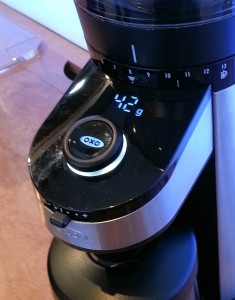 I’ve saved Oxo for last. Oxo makes a lot of rubber-sided kitchen hand tools. I have their can opener, and nothing else, but it works well. So what are they doing in the coffeemaker business? Apparently, according to their charming French Senior Product Manger, Claire Ashley, they decided to enter the coffeemaking market after analyzing the current one and realizing how mediocre most coffeemakers are. Obviously, CoffeeCompanion fans know this, and also know I simply ignore most of the ones that can’t extract properly, but having searched last year for my Consumer’s Digest report, I can say that likely 80% of the ones in mainstream department stores are genetic failures in the kitchen.
I’ve saved Oxo for last. Oxo makes a lot of rubber-sided kitchen hand tools. I have their can opener, and nothing else, but it works well. So what are they doing in the coffeemaker business? Apparently, according to their charming French Senior Product Manger, Claire Ashley, they decided to enter the coffeemaking market after analyzing the current one and realizing how mediocre most coffeemakers are. Obviously, CoffeeCompanion fans know this, and also know I simply ignore most of the ones that can’t extract properly, but having searched last year for my Consumer’s Digest report, I can say that likely 80% of the ones in mainstream department stores are genetic failures in the kitchen.
Oxo first showed me their grinder; that they showed me the grinder first is a good sign. It has a built-in scale and automatic shutoff by weight. The upper beans bin is removable and sealable. If it grinds properly, (only testing can determine this) they might really have a powerful entry. They are introducing two coffeemakers. First, the 1 liter one has a glass tube so water at its hottest never touches plastic (although the grounds holder is BPA-free plastic). They have also developed algorithmic internal software that allows you to do various batch sizes and still deliver the same grounds/water contact time. This results in consistent tasting brew, whether you make two cups or eight. If it works as promised, it’s a great feature.
The second model offers a larger 12 – 4.5 oz cup batch size. According to Ms Ashley, Oxo designers recognized the heating limitations creating enough pumped hot water to do this, which she says is impossible with current technology. So, they are heating all the water at once, and then release it at approved brewing temperature. Both brewers feature tubes to release brew at carafe bottom in order to mix coffee before pouring. An unusual innovation is a transformer feature where you can remove the boiler and use it as a water kettle. Exciting!
As Sherlock Holmes, and later Carly Simon, say: These are the good old days!
by Coffee Kevin | Jul 8, 2014 |
 The Aeropress marks the longest I’ve ever waited for formally review a product. I met inventor Alan Adler nine or more years ago. We were introduced by then Bunn VP Aimee Markelz. Just to show how gracious some people can be even in an industry with such hot competition as coffeemakers, Ms Markelz was walking through the International Housewares show before showtime and spied this new coffeemaker. When I did my usual walkaround at Housewares she handed me a slip of paper with the Aeropress booth number on it. She told me she thought I’d find it interesting. I did. I do.
The Aeropress marks the longest I’ve ever waited for formally review a product. I met inventor Alan Adler nine or more years ago. We were introduced by then Bunn VP Aimee Markelz. Just to show how gracious some people can be even in an industry with such hot competition as coffeemakers, Ms Markelz was walking through the International Housewares show before showtime and spied this new coffeemaker. When I did my usual walkaround at Housewares she handed me a slip of paper with the Aeropress booth number on it. She told me she thought I’d find it interesting. I did. I do.
The reason I waited so long to review it? I guess I took it for granted. But now I feel a little guilty and negligent. Or it’s such an open-ended device it all depends on how you use it. Honestly, I can’t tell you why. Is it because it has no engine, no water heater? That can’t be. Neither does the Sowden SoftBrew nor does the Chemex. Is it due to it’s cost – as in low? Nope, I’ve reviewed the Melitta single cup, and I’ve packed three of them into knapsacks of my college bound sons.
So, let me stop the self analysis and proceed to make amends for my lengthy review time. The Aeropress, though wholly innovative and original in its design, seems to provide the features of all the world’s coffeemakers through time. Like a modern Hollywood film, it has elements of all that came before it in its genre. The Aeropress has some elements of the French press, namely the press, both in name and procedure. The Aeropress has elements of the Chemex, particularly in its filter and its brewing temperature recommendations. Finally it has elements with the vacuum or siphon coffeemaker, mainly its mass-compressed grounds puck.
The Aeropress is perhaps the ultimate flexible coffeemaker. It can be used conventionally, where it gives the impression of being a somewhat leaky manual drip maker. It can be inverted, placed upside down, its filter cap removed and it becomes a settling tank where coffee is steeped like a tea before its cap is replaced, it is flipped over and then pressed to completion. Which is it for me? I’ve spent several years in each camp. Finally (or just lately?)
I’ve settled on the conventional method. I believe I’d done this out of simplicity, and perhaps a little out of my desire to set the record straight on what I consider the Aeropress myth of being a leaky drip maker. When people pour a little hot water into the Aeropress and stir so that the grounds get plenty wet and are allowed to swell and settle before the press is used, a minute amount of water travels through the grounds and out through the filter and into your cup. There is nothing about this that is going to affect your coffee end result. It is no different than the initial drips of any drip coffee maker. Coffee is all about grounds/water contact time and nothing else.
Aeropress brewing temperature is, or should be, controversial. I know it’s manual so you can use whatever your lil’ water heatin’ vessel can provide. I have a fancy schmancy BonaVita kettle with dial and hold temperature settings. Inventor Alan Adler says Aeropress competitions tend to be won at brewing temps of 185°F for the super light roasted coffees and 175°F for medium to dark roasts. What does all this mean to the coffee industry, who’s fought so long and hard to convince us to brew hotter into their 10 degree (195F-205F) window? That’s a tough question and likely a subject for a different article. For the moment I’m going to use the ole’ reviewer copout #7 that we should view the Aeropress on its own terms. Of course you can use your Aeropress at whatever temperature you prefer, but after a number of tests in my kitchen, I’m inclined to operate mine at the light roast winning temperature: 185°F.
Speaking of roasts, here are some coffees that I tested:
- George Howell Coffee’s La Minita I got spectacular results with this coffee. Man that is one complex beverage as brewed in the Aeropress. Like a great symphony orchestra, La Minita’s Bill McAlpin is unable to create a bad note. This coffee, third wave light roast and all, is just a perfect match for the Aeropress. Did I hear chocolate? I know most coffees give this note at this brewing temperature, but it’s the quality of chocolate note that this coffee provides.
- Sight Glass Colombian Finca Alcatraz – I recently became smitten with this coffee in all brewing methods. I don’t know what to say except I just enjoyed its richness and cocoa and nougat notes. I admit I feel the lush fruit notes are boosted by moving the brewing temperature back into the 190°s.
- Counter Culture Finca El Puente Honduras – I couldn’t resist trying some coffee farmed by CoffeeCon presenters Marysabel Caballero and Moisés Herrera and their latest coffee. Counter Culture roasted it at the light end, although to be fair, not too light, which I found to be a perfect match for Alan’s observed 185°F brewing temperature. Okay, I probably sneaked up to 190°F. I got that black cherry flavor kick right away.
Conclusion: The Aeropress is just a wonderful brewer. If you are caught between gigs, you likely can afford it. It is easy to use, to clean up. And, it delivers an ultra clean taste, with plenty of viscosity but virtually no sediment. If this is the cup you seek, the Aeropress is a brewer used must have in your brewing arsenal. Period.
Photo note: Aeropress Inventor Alan Adler says, “I do like clear glass which reveals the flow (drip), but recommend a wide-bottom, sturdy mug like the attached pic.”
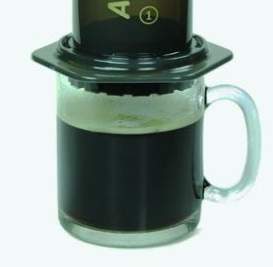
by GuestBlogger | Aug 18, 2013 |
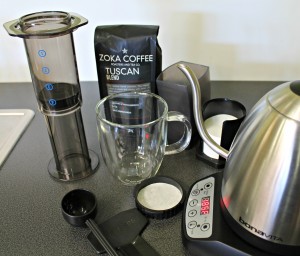
Much like Coffee Kevin, our crew tests and evaluates every brewing gadget large or small and we share our feedback. Some equipment is strictly for commercial use: Does anyone need 240 cups of coffee per hour at home? Maybe, it depends on how many coffee drinkers live with you — I know that I could put a serious dent in that! Some coffee crazes easily translate from commercial cafes to your kitchen counter, yet due to sheer volume or prohibitive cost, some do not.
In conjunction with the World Barista Championship that was held during the Melbourne International Coffee Expo in May 2013, another (much quieter!) competition occurred: The World AeroPress Championship. Now here’s a coffee trend that everyone can try on for size. The initial set up for this brew method runs about $150 for an AeroPress coffee maker, pack of filters, variable temperature kettle and kitchen scale. All you need to bring to the kitchen table is a little caffeinated curiosity, your coffee and a cup.
Here’s a look at the winning “recipe” from barista Jeff Verellen of Belgium. We were interested to find out how it tasted compared with our standard AeroPress brew, so we tried it ourselves. Here are the steps we followed:
• 17 grams of coffee or espresso ground slightly coarser than drip
• Rinsed paper filter
• AeroPress in regular position (some people use an inverted technique)
• 50 grams of water at 182F for the bloom
• Bloom for 40 seconds
• Nicely wet all grounds and lightly agitate it
• Very slowly add 215 grams of water at 175F for about 30 seconds
• Press very gently for about 30 seconds
Jeff mentioned he favored bolder coffees for use in the AeroPress so we chose a flavorful espresso blend that we regularly enjoy. 17 grams corresponds to about 1 rounded AeroPress scoop, but we weighed ours to be certain of the measurement. His grind, however, is somewhat controversial: Unless something was lost in translation, he reportedly used a coarser grind than drip, while conventional wisdom has the grind somewhere between espresso and fine drip.
Water temperature is not what you’d expect either. The familiar 200F temperature threshold is not achieved and it still creates a proper extraction. You can experiment yourself to confirm this. With a variable temperature kettle it is easy to get the right (lower) temperature for extraction. You could also use a regular kettle with a glass measuring cup and an inexpensive drink thermometer. We placed the AeroPress over a double-wall glass mug and it was beautiful to watch and listen to the resulting coffee droplets. In about five minutes, we had a single cup of coffee with the AeroPress from start to finish. The aroma was a little more subtle, but the coffee was smooth, even and full of sweet caramel notes — just as we had hoped.
Then I compared these delicious winning results to my co-worker Jess’ morning AeroPress coffee habit:
• 34 grams of coffee ground slightly finer than drip (2 rounded AeroPress scoops)
• AeroPress in regular position
• No filter rinse, no pre-infusion
• Fill to the (4) measure with water around 185F
• Nicely wet all grounds and use the included stir stick
• Wait 30 seconds
• Push down hard with even pressure, about 30 seconds
The included AeroPress instructions indicate for two scoops to fill the tube with water to the (2) measure and to make a concentrate rather than filling to (4) with this dosage. The resulting concentrate can then be diluted (as if!). Even with her predilection for up-dosing and lack of dilution, she brewed a cup that was not bitter or sludgy. You have to love a device that still operates well whether you follow the printed directions or not.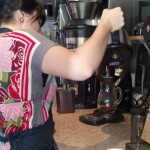
Besides price, taste and ease of use, there is also the portability factor: It is lightweight and virtually unbreakable. The AeroPress is a practical option for anyone who would like to take his or her fresh cup of Joe on the go. I have heard tales of AeroPress prepped successfully in campgrounds and college dorms — even on a commercial airliner mid-flight! The aftermath is also manageable to clean because the spent grounds are pushed out after the extraction and it is fairly solid like an espresso puck for easy disposal. A quick hot water rinse and occasional soft scrub are all that is required to clean.
While any coffee brewing method can be taken to scientific extremes, the versatility of this simple plastic device continues to amaze. Right side up, inverted, pre-infusion, paper versus metal filters –you can try all of the tricks of the trade to see what tastes best for your coffee or espresso blend. What I’ve outlined here are just two of a seemingly endless number of variations.
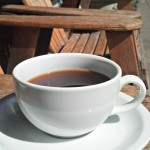 The AeroPress is fun to use and that should come as no surprise since it is from the same Stanford inventor behind the Aerobie Flying Disc. While it may be easy to dismiss the device based on looks (think Habitrail meets water pipe), it makes a seriously good cup of strong coffee. Recently, my local cafe started offering house roasted single origins prepped via AeroPress; I can’t think of a more glowing endorsement from the world of specialty coffee. For home or cafe, the AeroPress is here to stay. Don’t knock it till you try it!
The AeroPress is fun to use and that should come as no surprise since it is from the same Stanford inventor behind the Aerobie Flying Disc. While it may be easy to dismiss the device based on looks (think Habitrail meets water pipe), it makes a seriously good cup of strong coffee. Recently, my local cafe started offering house roasted single origins prepped via AeroPress; I can’t think of a more glowing endorsement from the world of specialty coffee. For home or cafe, the AeroPress is here to stay. Don’t knock it till you try it!

Samantha Joyce is a writer for Seattle Coffee Gear and enjoys sharing her knowledge of all things coffee
 Bonavita coffee makers were originally Melitta units, the first generation designed in Germany by Melitta, who license their brand name to Hamilton Beach in the US.
Bonavita coffee makers were originally Melitta units, the first generation designed in Germany by Melitta, who license their brand name to Hamilton Beach in the US.
















